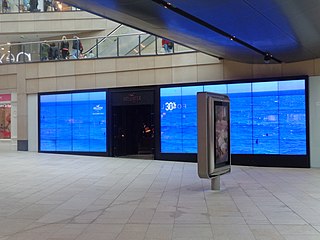Customer relationship management (CRM) is a process in which a business or other organization administers its interactions with customers, typically using data analysis to study large amounts of information.
E-commerce is the activity of electronically buying or selling products on online services or over the Internet. E-commerce draws on technologies such as mobile commerce, electronic funds transfer, supply chain management, Internet marketing, online transaction processing, electronic data interchange (EDI), inventory management systems, and automated data collection systems. E-commerce is the largest sector of the electronics industry and is in turn driven by the technological advances of the semiconductor industry.

Marketing is the act of satisfying and retaining customers. It is one of the primary components of business management and commerce.

Sales are activities related to selling or the number of goods sold in a given targeted time period. The delivery of a service for a cost is also considered a sale. A period during which goods are sold for a reduced price may also be referred to as a "sale".
Marketing research is the systematic gathering, recording, and analysis of qualitative and quantitative data about issues relating to marketing products and services. The goal is to identify and assess how changing elements of the marketing mix impacts customer behavior.

Distribution is the process of making a product or service available for the consumer or business user who needs it, and a distributor is a business involved in the distribution stage of the value chain. Distribution can be done directly by the producer or service provider or by using indirect channels with distributors or intermediaries. Distribution is one of the four elements of the marketing mix: the other three elements being product, pricing, and promotion.
Database marketing is a form of direct marketing that uses databases of customers or potential customers to generate personalized communications in order to promote a product or service for marketing purposes. The method of communication can be any addressable medium, as in direct marketing.

Online shopping is a form of electronic commerce which allows consumers to directly buy goods or services from a seller over the Internet using a web browser or a mobile app. Consumers find a product of interest by visiting the website of the retailer directly or by searching among alternative vendors using a shopping search engine, which displays the same product's availability and pricing at different e-retailers. As of 2020, customers can shop online using a range of different computers and devices, including desktop computers, laptops, tablet computers and smartphones.

Business-to-business is a situation where one business makes a commercial transaction with another. This typically occurs when:
B2B e-commerce, short for business-to-business electronic commerce, is the sale of goods or services between businesses via an online sales portal. In general, it is used to improve the efficiency and effectiveness of a company's sales efforts. Instead of receiving orders using human assets manually – by telephone or e-mail – orders are received digitally, reducing overhead costs.
Business marketing is a marketing practice of individuals or organizations. It allows them to sell products or services to other companies or organizations, who either resell them, use them in their products or services, or use them to support their work.
The target audience is the intended audience or readership of a publication, advertisement, or other message catered specifically to the previously intended audience. In marketing and advertising, the target audience is a particular group of consumer within the predetermined target market, identified as the targets or recipients for a particular advertisement or message.
Industrial marketing or business-to-business marketing is the marketing of goods and services by one business to another. Industrial goods are those an industry uses to produce an end product from one or more raw material. The term, industrial marketing has largely been replaced by the term B2B marketing.
Customer engagement is an interaction between an external consumer/customer and an organization through various online or offline channels. According to Hollebeek, Srivastava and Chen S-D logic-Definition of customer engagement is "a customer’s motivationally driven, volitional investment of operant resources, and operand resources into brand interactions," which applies to online and offline engagement.
Consumer-to-business (C2B) is a business model in which consumers (individuals) create value and businesses consume that value. For example, when a consumer writes reviews or when a consumer gives a useful idea for new product development then that consumer is creating value for the business if the business adopts the input. In the C2B model, a reverse auction or demand collection model, enables buyers to name or demand their own price, which is often binding, for a specific good or service. Inside of a consumer to business market the roles involved in the transaction must be established and the consumer must offer something of value to the business.
Business-to-employee (B2E) electronic commerce uses an intrabusiness network which allows companies to provide products and/or services to their employees. Typically, companies use B2E networks to automate employee-related corporate processes. B2E portals have to be compelling to the people who use them. Companies are competing for eyeballs of their employees with eBay, yahoo and thousands of other web sites. There is a huge percentage of traffic to consumer web sites comes from people who are connecting to the net at the office.
Affinity marketing is a concept that consists of a partnership between a company (supplier) and an organization that gathers persons sharing the same interests to bring a greater consumer base to their service, product or opinion. This partnership is known as an affinity group.
Customer to customer markets provide a way to allow customers to interact with each other. Traditional markets require business to customer relationships, in which a customer goes to the business in order to purchase a product or service. In customer to customer markets, the business facilitates an environment where customers can sell goods or services to each other. Other types of markets include business to business (B2B) and business to customer (B2C).
Marketing automation refers to software platforms and technologies designed for marketing departments and organizations automate repetitive tasks and consolidate multi-channel interactions, tracking and web analytics, lead scoring, campaign management and reporting into one system. It often integrates with customer relationship management (CRM) and customer data platform (CDP) software.
There are many types of e-commerce models, based on market segmentation, that can be used to conducted business online. The 6 types of business models that can be used in e-commerce include: Business-to-Consumer (B2C), Consumer-to-Business (C2B), Business-to-Business (B2B), Consumer-to-Consumer (C2C), Business-to-Administration (B2A), and Consumer-to-Administration




